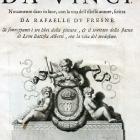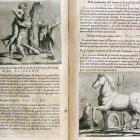Treatise on Painting by Lionardo Da Vinci, Paris, 1651 (RV C.IV.9 preziosi)
Pages containing human figures and a horse, which accompany the precepts of Leonardo’s Treatise on Painting included in the Editio Princeps printed in Italian in 1651 in Paris (in the same year a French edition was also published).
This work was brought into being thanks to a group linked by a passion for art and a high level of culture. Chief among them was Cavaliere Cassiano dal Pozzo, a descendant of a noble Piedmontese family and personal secretary to Cardinal Francesco Barberini, known as the “Cardinal Master”.
For the iconographic part Cassiano was helped by his friend, the painter Nicolas Poussin, who created the wonderful drawings, but whose graphical interpretation of Leonardo's artistic theory was far removed from the original drawings and closer to the style of the time.
The drawings of the diagrams that demonstrate scientific arguments were drawn for the editio princeps by Pierfrancesco degli Alberti (1584-1638), author of the Maps in Bosio’s Subterranean Rome.
The first printed edition is important because it filled a void, which had lasted more than a century. That of a publication of Leonardo's precepts that could help to disseminate its contents more widely than the numerous manuscripts that had circulated exclusively among dedicated scholars in Lombardy and Florence the century before.
From a typographical and iconographic point of view it is a magnificent edition. The format is in folio, the pages are well proportioned and it benefits from the insertion of a bibliography of art books considered to be among the first ever printed. Additionally, to “not leave empty and useless paper” all the blank spaces at the beginning and the end of the chapters are filled with elaborate prints, in the most part drawn by Errard and engraved by Georges Tournier, and formerly used for the Parallèle de l’Architecture Antique et Moderne, publisihed by Chambray in 1650.









